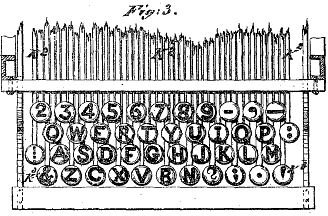Who Designed the Qwerty Keyboard? If You Ever Wondered Who Invented the Qwerty Keyboard, We Have the Answer!
Do You Take Keyboards for Granted?
We use keyboards constantly in our daily lives, either on telephone keypads, smartphone touch-screens, when visiting a hi-tech building or doctor’s surgery, or even when gaming on consoles. Most notably, we use a keyboard to interact with computers – the keyboard is an integral part of the user interface and is used to create e-mails, launch programs, write articles like this or even play games.
Keyboards are also available in different shapes and sizes for people with small hands and big hands, and they are also made to different specifications for reasons of ergonomic comfort.
Of course, you know all of this – just like you know that the keyboard you use is referred to as the QWERTY keyboard because of the arrangement of the first six alphabetical keys
What you might not know, however, is that before the creation of the QWERTY keyboard there was a different arrangement of the keys…
Who Designed the QWERTY Keyboard?
Thanks to the efforts of Christopher Latham Sholes, the QWERTY keyboard was first unveiled by Remington in 1878 after many years of research by Sholes (with help from Carlos Glidden and Samuel Soule, among others) to develop a typewriter that could be used quickly and intuitively, with access to regularly used character pairings enhanced over those that would be less used.
In order to establish the arrangement of the keys, Sholes took notice of research into the most regular combinations of character pairs in the English language; this research had a strong impact on his typewriter, which is why the letters T and H are closely placed on the modern QWERTY keyboard.
This research and subsequent testing saw Sholes build over 50 devices which his business partner James Densmore then attempted to sell, with the feedback from each demonstration resulting in Sholes’ final design which was sold to Remington.
When is “QWERTY” not “QWERTY”? When It is “QWE.TY”!
In fact, despite all his years of effort, Sholes didn’t actually create the QWERTY keyboard; he created the QWE.TY keyboard.
The final device that he developed before the design was sold to Remington was for a device with a top row of letters that was slightly different from the one Remington mass-produced. Their changes prior to manufacture saw the R key moved to the top line, as well as a rearrangement of the second and third rows of letters.
However the spirit of Sholes’ keyboard remained in Remington’s typewriters and such was the strength of the design and some of the conventions that it remains the most popular text entry format in the world today.
Sholes’ Keyboard Conventions
In designing and building many versions of the keyboard, Sholes discovered various shortcuts and space saving devices.
Along with the close positioning of the T and H, Sholes developed the keyboard to use as few keys as possible in order to minimise manufacturing costs of the prototype. This was something that wasn’t really changed until the 1970s and the early years of the computing revolution, which resulted in early QWERTY keyboards having neither a 1, 0 or ! key.
Instead, the 1 and 0 would be typed using an upper case “i” or a lower case “L”; meanwhile the “!” symbol would be created by typing an apostrophe, then tapping the backspace key and then entering a “.”.
Luckily we’re not so restricted by space or manufacturing costs in the 21st century, with new computer keyboards available for just a few dollars.
References
Sources:
- reference.com, https://www.reference.com/browse/Christopher+Sholes
- Author experience
Images:
- US Patent diagram by CL Sholes. Public Domain image via https://upload.wikimedia.org/wikipedia/commons/8/87/QWERTY_1878.png
